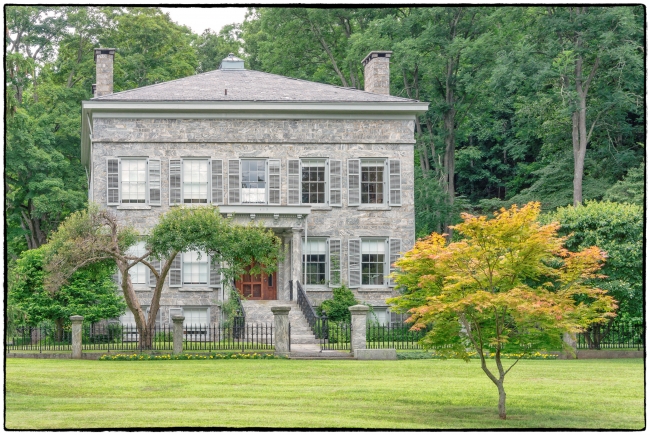Back in August, 2013 I went to North Salem and took some pictures (see: North Salem). On the way home I noticed this fine old building. At the time I wasn’t able to find any additional information and I remarked in the blog post: “I don’t know what this house is (seems to be a private residence) and I don’t even remember if it’s in North Salem. If it’s not it’s certainly close by”.
We have some friends who transferred to Thailand, and are returning in a month or so. They asked us to check out an area where they would like to rent while looking to buy a new house. That area is Somers, NY and we went yesterday. On our return I started to see what I could find out about Somers on the internet and ‘lo and behold’ I came across a picture of this house. It turns out I was right. The house in not in North Salem. It’s in Somers.
It’s the Gerard Crane House and according to Wikipedia:
The Gerard Crane House is a private home located on Somerstown Turnpike (U.S. Route 202) opposite Old Croton Falls Road in Somers, New York, United States. It is a stone house dating to the mid-19th century, built by an early circus entrepreneur in his later years.
The house itself is an unusually sophisticated late application of the Greek Revival architectural style. The interior features a high level of decoration, particularly English Renaissance-style plaster moldings on the ceilings that are not commonly found in rural Greek Revival houses. It is the center of a 25-acre (10 ha) estate that includes not only the original outbuildings but an original section of Somerstown Turnpike and one of its mileposts.
It remains largely as it was originally built. In 1985 the area was designated a historic district and listed on the National Register of Historic Places. It is the northernmost such listing in Westchester County.
…
Crane and his brother Thaddeus, descendants of a colonel in the Revolutionary War, moved to Somers from their hometown, nearby North Salem, in 1823. They had become active in the new business of exhibiting exotic animals, and records show that they had taken a lion to the Carolinas three years earlier. They bought land from Hachaliah Bailey, whose exhibition of Old Bet at the building now known as the Elephant Hotel is considered the beginning of the circus in America, that they would later build on.
They added to their menagerie, got partners, and exhibited as far as west as the Mississippi River. They were among the founders of an early trade organization called the Zoological Institute, which collapsed in the Panic of 1837. Crane himself was more fortunate; he served as a director, and later president of a local bank, and had just concluded four years as town supervisor at the outset of the panic.
In 1849, having married Roxana Purdy, he had the house built. Its extensive detailing and finely crafted stonework are features of a country manor house in the highest Greek Revival tradition. The English Renaissance-style molded plasterwork on the first floor ceilings, common in urban homes of this type but rare in rural variants, reflects Crane’s cosmopolitan tastes.
The next year’s census shows the Cranes at that address, with their six children and one other woman. He died in 1872. The house and estate have remained a private residence since then. Other than the barn’s gambrel roof and the conversion of the main house’s music room into a kitchen during the 1980s, there have been no significant alterations to the property.

